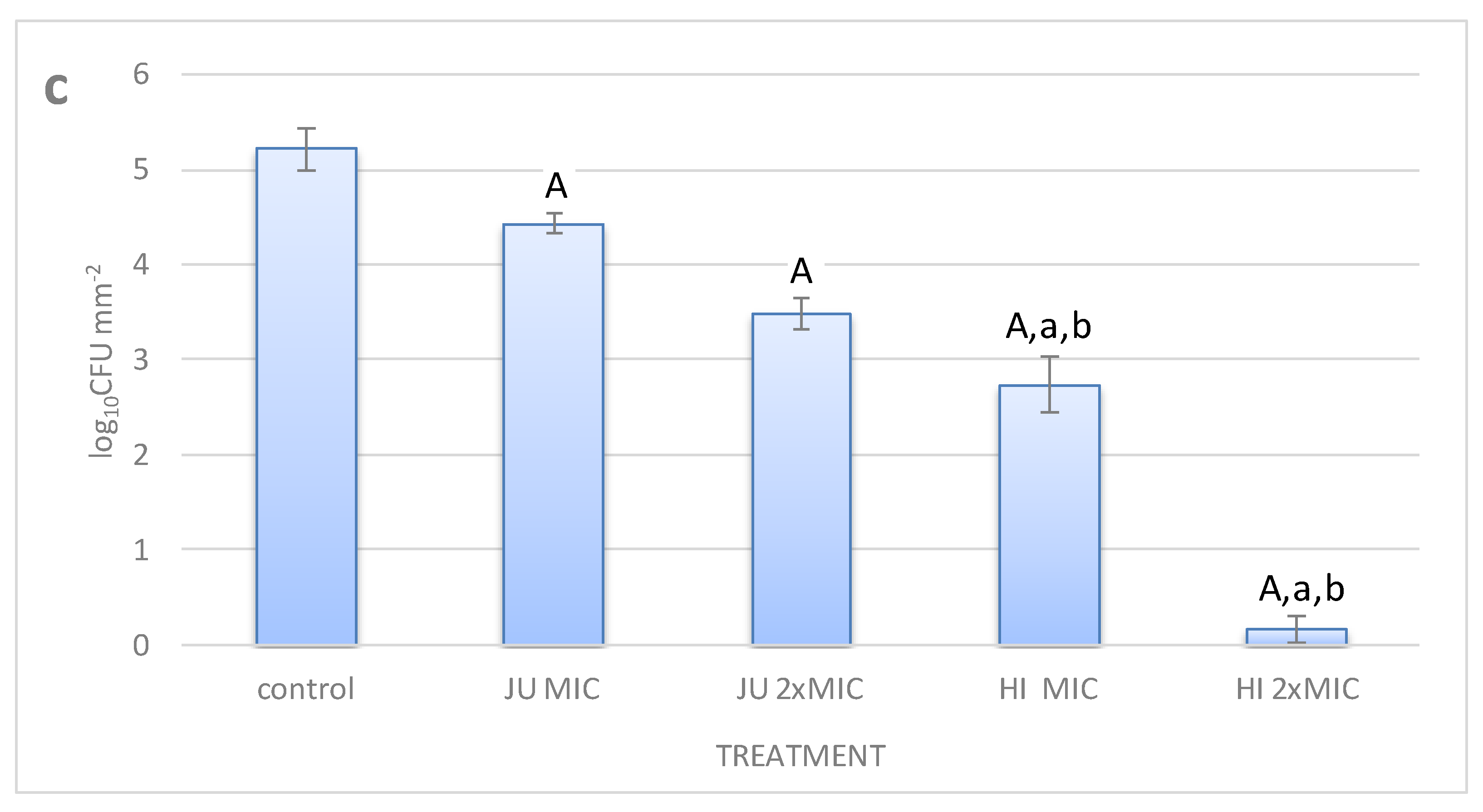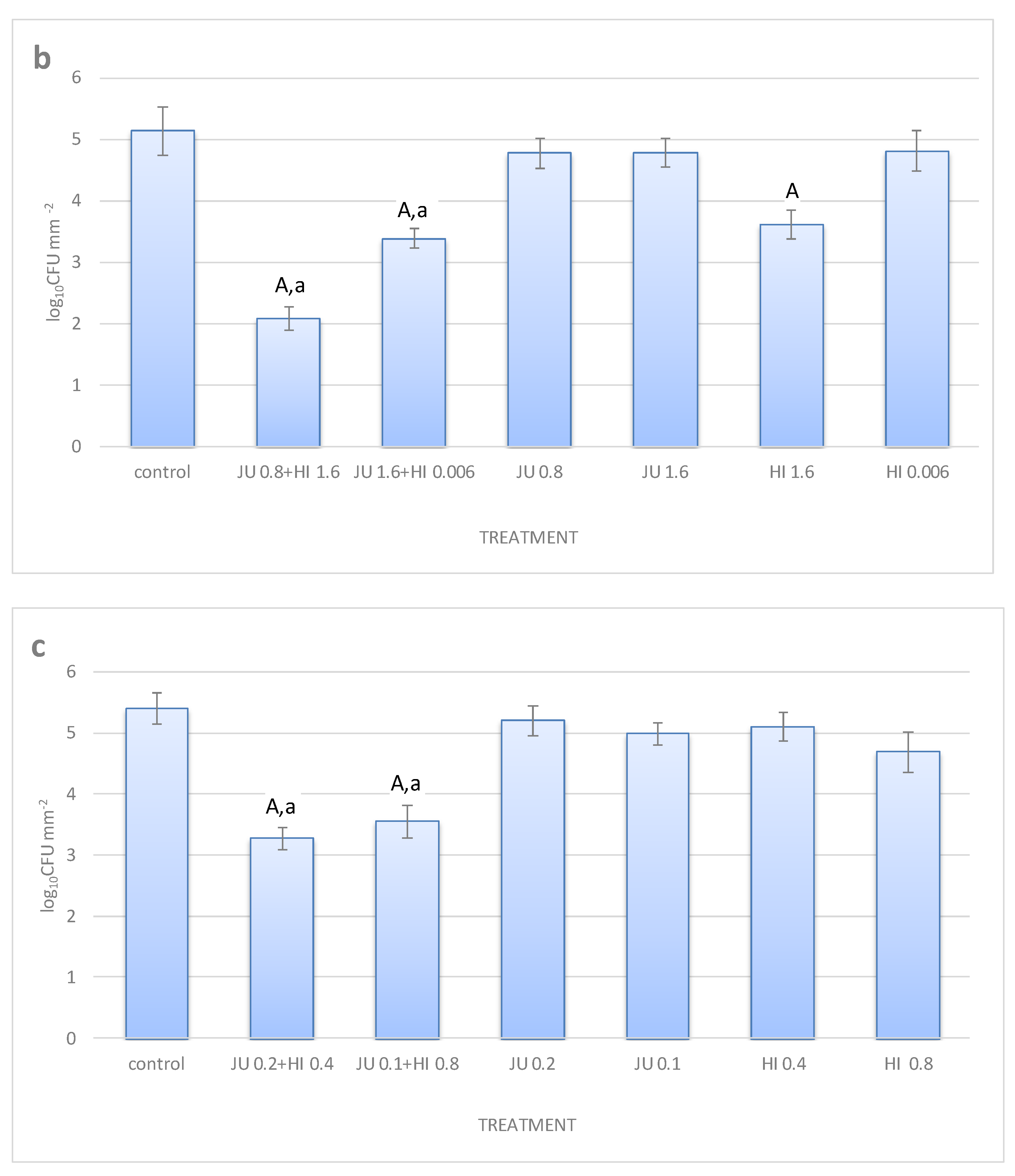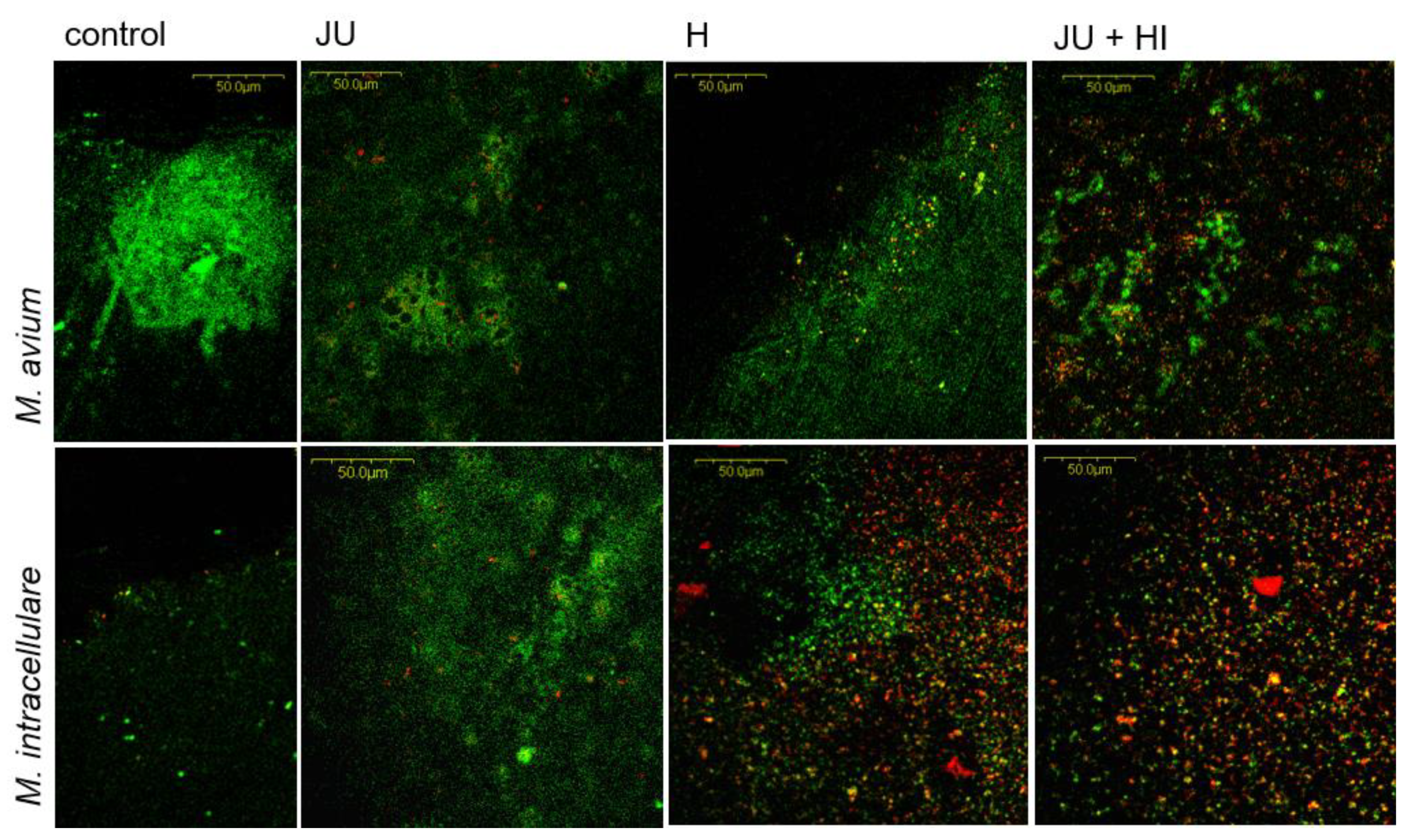Biofilm Degradation of Nontuberculous Mycobacteria Formed on Stainless Steel Following Treatment with Immortelle (Helichrysum italicum) and Common Juniper (Juniperus communis) Essential Oils
Abstract
1. Introduction
2. Material and Methods
2.1. Essential Oils
2.2. Strains and Growth Media
2.3. Sterile Tap Water Sample
2.4. Checkerboard Synergy Method
2.5. Effect of Juniperus communis and Helichrysum italicum Essential Oils on Mycobacterial Biofilm on Stainless Steel Discs in Sterilized Tap Water
2.6. Determination of Cell Viability in Biofilms Growing on Stainless Steel Coupons, after Treatment with Juniperus communis and Helichrysum italicum Essential Oils
2.7. Statistical Analysis
3. Results
3.1. Checkerboard Synergy Method
3.2. Effect of Juniperus communis and Helichrysum italicum Essential Oils on Mycobacterial Biofilm on Stainless Steel Discs in Sterilized Tap Water
3.3. Percentage of Degradation of Mycobacterial Biofilms on Stainless Steel Discs
3.4. Cell Viability of Biofilm on Stainless Steel Discs Treated with Juniperus communis and Helichrysum italicum Essential Oils
4. Discussion
5. Conclusions
Author Contributions
Funding
Institutional Review Board Statement
Informed Consent Statement
Data Availability Statement
Acknowledgments
Conflicts of Interest
References
- Cambau, E.; Drancourt, M. Steps towards the discovery of Mycobacterium tuberculosis by Robert Koch, 1882. Clin. Microbiol. Infect. 2014, 20, 196–201. [Google Scholar] [CrossRef]
- Forbes, B.A.; Hall, G.S.; Miller, M.B.; Novak, S.M.; Rowlinson, M.C.; Salfinger, M.; Somoskovi, A.; Warshauer, D.M.; Wilson, M.L. Practice Guidelines for Clinical Microbiology Laboratories: Mycobacteria. Clin. Microbiol. Rev. 2018, 31. [Google Scholar] [CrossRef]
- Sousa, S.; Bandeira, M.; Carvalho, P.A.; Duarte, A.; Jordao, L. Nontuberculous mycobacteria pathogenesis and biofilm assembly. Int. J. Mycobacteriol. 2015, 4, 36–43. [Google Scholar] [CrossRef]
- Faria, S.; Joao, I.; Jordao, L. General Overview on Nontuberculous Mycobacteria, Biofilms, and Human Infection. J. Pathog. 2015, 2015, 809014. [Google Scholar] [CrossRef]
- Pfyffer, G.E.; Brown-Elliott, B.A.; Wallace, R.J.J. Mycobacterium: General Characteristics, Isolation, and Staining Procedures. In Manual of Clinical Microbiology, 8th ed.; Murray, P.R., Ed.; American Society of Microbiology: Washington, DC, USA, 2003; Volume 1, pp. 532–584. [Google Scholar]
- Vincent, V.; Brown-Elliott, B.A.; Jost, K.C.; Wallace, R.J.J. Mycobacterium: Phenotypic and Genotypic Identification. In Manual of Clinical Microbiology, 8th ed.; Murray, P.R., Ed.; American Society of Microbiology: Washington, DC, USA, 2003; Volume 1, pp. 560–584. [Google Scholar]
- Jankovic, M.; Zmak, L.; Krajinovic, V.; Viskovic, K.; Crnek, S.S.; Obrovac, M.; Haris, V.; Jankovic, V.K. A fatal Mycobacterium chelonae infection in an immunosuppressed patient with systemic lupus erythematosus and concomitant Fahr’s syndrome. J. Infect. Chemother. 2011, 17, 264–267. [Google Scholar] [PubMed]
- Halstrom, S.; Price, P.; Thomson, R. Review: Environmental mycobacteria as a cause of human infection. Int. J. Mycobacteriol 2015, 4, 81–91. [Google Scholar] [CrossRef] [PubMed]
- Nishiuchi, Y.; Iwamoto, T.; Maruyama, F. Infection Sources of a Common Non-tuberculous Mycobacterial Pathogen, Mycobacterium avium Complex. Front. Med. 2017, 4, 27. [Google Scholar] [CrossRef] [PubMed]
- Tortoli, E. Clinical manifestations of nontuberculous mycobacteria infections. Clin. Microbiol. Infect. 2009, 15, 906–910. [Google Scholar] [CrossRef] [PubMed]
- De Groote, M.A.; Huitt, G. Infections due to rapidly growing mycobacteria. Clin. Infect. Dis. 2006, 42, 1756–1763. [Google Scholar] [CrossRef]
- Falkinham, J.O.; Pruden, A.; Edwards, M. Opportunistic Premise Plumbing Pathogens: Increasingly Important Pathogens in Drinking Water. Pathogens 2015, 4, 373–386. [Google Scholar] [CrossRef] [PubMed]
- Feazel, L.M.; Baumgartner, L.K.; Peterson, K.L.; Frank, D.N.; Harris, J.K.; Pace, N.R. Opportunistic pathogens enriched in showerhead biofilms. Proc. Natl. Acad. Sci. USA 2009, 106, 16393–16399. [Google Scholar] [CrossRef]
- Richards, J.P.; Ojha, A.K. Mycobacterial Biofilms. Microbiol. Spectr. 2014, 2, 1–11. [Google Scholar] [CrossRef] [PubMed]
- Hall-Stoodley, L.; Keevil, C.W.; Lappin-Scott, H.M. Mycobacterium fortuitum and Mycobacterium chelonae biofilm formation under high and low nutrient conditions. J. Appl. Microbiol. 1998, 85 (Suppl. 1), 60S–69S. [Google Scholar] [CrossRef] [PubMed]
- Nikolić, T.; Rešetnik, I. Plant uses in Croatia. Phytol. Balc. 2007, 13, 229–238. [Google Scholar]
- Malenica Staver, M.; Gobin, I.; Ratkaj, I.; Petrović, M.; Vulinović, A.; Dinarina-Sablić, M.; Broznić, D. In vitro antiproliferative and antimicrobial activity of the essential oil from the flowers and leaves of Helichrysum italicum (Roth) G. Don growing in Central Dalmatia (Croatia). J. Essent. Oil Bear. Pl. 2018, 21, 77–91. [Google Scholar] [CrossRef]
- Bakkali, F.; Averbeck, S.; Averbeck, D.; Idaomar, M. Biological effects of essential oils—A review. Food Chem. Toxicol. 2008, 46, 446–475. [Google Scholar] [CrossRef]
- Bag, A.; Chattopadhyay, R.R. Evaluation of Synergistic Antibacterial and Antioxidant Efficacy of Essential Oils of Spices and Herbs in Combination. PLoS ONE 2015, 10, e0131321. [Google Scholar] [CrossRef] [PubMed]
- Bassole, I.H.; Juliani, H.R. Essential oils in combination and their antimicrobial properties. Molecules 2012, 17, 3989–4006. [Google Scholar] [CrossRef]
- Dorman, H.J.; Deans, S.G. Antimicrobial agents from plants: Antibacterial activity of plant volatile oils. J. Appl. Microbiol. 2000, 88, 308–316. [Google Scholar] [CrossRef]
- Newton, S.M.; Lau, C.; Wright, C.W. A review of antimycobacterial natural products. Phytother. Res. 2000, 14, 303–322. [Google Scholar] [CrossRef]
- Sawicki, R.; Golus, J.; Przekora, A.; Ludwiczuk, A.; Sieniawska, E.; Ginalska, G. Antimycobacterial Activity of Cinnamaldehyde in a Mycobacterium tuberculosis(H37Ra) Model. Molecules 2018, 23, 2381. [Google Scholar] [CrossRef]
- Klančnik, A.; Zorko, Š.; Toplak, N.; Kovač, M.; Bucar, F.; Jeršek, B.; Smole Možina, S. Antiadhesion activity of juniper (Juniperus communis L.) preparations against Campylobacter jejuni evaluated with PCR-based methods. Phytother. Res. 2018, 32, 542–550. [Google Scholar] [CrossRef]
- Angioni, A.; Barra, A.; Russo, M.T.; Coroneo, V.; Dessiä, S.; Cabras, P. Chemical Composition of the Essential Oils of Juniperus from Ripe and Unripe Berries and Leaves and Their Antimicrobial Activity. J. Agric. Food Chem. 2003, 51, 3073–3078. [Google Scholar] [CrossRef]
- Rezvani, S.; Ali Rezai, M.; Mahmodi, N. Analysis of Essential Oils of Juniperus polycarpous and Juniperus communis. Asian J. Chem. 2007, 19, 5019–5022. [Google Scholar]
- Peruč, D.; Gobin, I.; Abram, M.; Broznić, D.; Svalina, T.; Štifter, S.; Staver, M.M.; Tićac, B. Antimycobacterial potential of the juniper berry essential oil in tap water. Arh. Hig. Rada. Toksikol. 2018, 69, 46–54. [Google Scholar] [CrossRef]
- Mastelic, J.; Politeo, O.; Jerkovic, I. Contribution to the analysis of the essential oil of Helichrysum italicum (Roth) G. Don. Determination of ester bonded acids and phenols. Molecules 2008, 13, 795–803. [Google Scholar] [CrossRef]
- Antunes Viegas, D.; Palmeira-de-Oliveira, A.; Salgueiro, L.; Martinez-de-Oliveira, J.; Palmeira-de-Oliveira, R. Helichrysum italicum: From traditional use to scientific data. J. Ethnopharmacol. 2014, 151, 54–65. [Google Scholar] [CrossRef] [PubMed]
- Mancini, E.; De Martino, L.; Marandino, A.; Scognamiglio, M.R.; De Feo, V. Chemical composition and possible in vitro phytotoxic activity of Helichrsyum italicum (Roth) Don ssp. italicum. Molecules 2011, 16, 7725–7735. [Google Scholar] [CrossRef]
- Jerkovic, I.; Marijanovic, Z.; Kus, P.M.; Tuberoso, C.I. Comprehensive Study of Mediterranean (Croatian) Propolis Peculiarity: Headspace, Volatiles, Anti-Varroa-Treatment Residue, Phenolics, and Antioxidant Properties. Chem. Biodivers. 2016, 13, 210–218. [Google Scholar] [CrossRef]
- Peruč, D.; Tićac, B.; Abram, M.; Broznić, D.; Štifter, S.; Staver, M.M.; Gobin, I. Synergistic potential of Juniperus communis and Helichrysum italicum essential oils against nontuberculous mycobacteria. J. Med. Microbiol. 2019, 68, 703–710. [Google Scholar] [CrossRef]
- Peruc, D.; Ticac, B.; Broznic, D.; Maglica, Z.; Sarolic, M.; Gobin, I. Juniperus communis essential oil limit the biofilm formation of Mycobacterium avium and Mycobacterium intracellulare on polystyrene in a temperature-dependent manner. Int. J. Environ. Health Res. 2020, 1–14. [Google Scholar] [CrossRef]
- Sarker, S.D.; Nahar, L.; Kumarasamy, Y. Microtitre plate-based antibacterial assay incorporating resazurin as an indicator of cell growth, and its application in the in vitro antibacterial screening of phytochemicals. Methods 2007, 42, 321–324. [Google Scholar] [CrossRef]
- Andrejak, C.; Almeida, D.V.; Tyagi, S.; Converse, P.J.; Ammerman, N.C.; Grosset, J.H. Characterization of mouse models of Mycobacterium avium complex infection and evaluation of drug combinations. Antimicrob. Agents Chemother. 2015, 59, 2129–2135. [Google Scholar] [CrossRef] [PubMed]
- Vasiljević, B.; Knežević-Vučković, J.; Mitić-Ćulafić, D.; Orčić, D.; Francišković, M.; Srdic-Rajic, T.; Jovanović, M.; Nikolić, B. Chemical characterization, antioxidant, genotoxic and in vitro cytotoxic activity assessment of Juniperus communis var. saxatilis. Food Chem. Toxicol. 2018, 112, 118–125. [Google Scholar] [CrossRef] [PubMed]
- White, R.L.; Burgess, D.S.; Manduru, M.; Bosso, J.A. Comparison of three different in vitro methods of detecting synergy: Time-kill, checkerboard, and E test. Antimicrob. Agents Chemother. 1996, 40, 1914–1918. [Google Scholar] [CrossRef] [PubMed]
- Balouiri, M.; Sadiki, M.; Ibnsouda, S.K. Methods for in vitro evaluating antimicrobial activity: A review. J. Pharm. Anal. 2016, 6, 71–79. [Google Scholar] [CrossRef] [PubMed]
- Teanpaisan, R.; Kawsud, P.; Pahumunto, N.; Puripattanavong, J. Screening for antibacterial and antibiofilm activity in Thai medicinal plant extracts against oral microorganisms. J. Tradit. Complement. Med. 2017, 7, 172–177. [Google Scholar] [CrossRef] [PubMed]
- Falkinham, J.O. Surrounded by mycobacteria: Nontuberculous mycobacteria in the human environment. J. Appl Microbiol. 2009, 107, 356–367. [Google Scholar] [CrossRef]
- Falkinham, J.O. Mycobacterium avium complex: Adherence as a way of life. AIMS Microbiol. 2018, 4, 428–438. [Google Scholar] [CrossRef]
- Steed, K.A.; Falkinham, J.O., 3rd. Effect of growth in biofilms on chlorine susceptibility of Mycobacterium avium and Mycobacterium intracellulare. Appl. Environ. Microbiol. 2006, 72, 4007–4011. [Google Scholar] [CrossRef]
- Peruč, D.; Gobin, I.; Broznić, D.; Malenica Staver, M.; Tićac, B. Influence of essential oil Helichrysum italicum (Roth) G. Don on the formation of non-tuberculous mycobacterial biofilm. Med. Flum. 2018, 54, 282–289. [Google Scholar] [CrossRef]
- Haziri, A.; Faiku, F.; Mehmeti, A.; Govori, S.; Abazi, S.; Daci, M.; Haziri, I.; Bytyqi-Damoni, A.; Mele, A. Antimicrobial properties of the essential oil of Juniperus communis (L.) growing wild in east part of Kosovo. Am. J. Pharmacol. Toxicol. 2013, 8, 128–133. [Google Scholar] [CrossRef]
- Munoz Egea, M.C.; Ji, P.; Pruden, A.; Falkinham Iii, J.O. Inhibition of Adherence of Mycobacterium avium to Plumbing Surface Biofilms of Methylobacterium spp. Pathogens 2017, 6, 42. [Google Scholar] [CrossRef]
- Esteban, J.; Martin-de-Hijas, N.Z.; Kinnari, T.J.; Ayala, G.; Fernandez-Roblas, R.; Gadea, I. Biofilm development by potentially pathogenic non-pigmented rapidly growing mycobacteria. BMC Microbiol. 2008, 8, 184. [Google Scholar] [CrossRef] [PubMed]
- Carter, G.; Wu, M.; Drummond, D.C.; Bermudez, L.E. Characterization of biofilm formation by clinical isolates of Mycobacterium avium. J. Med. Microbiol. 2003, 52, 747–752. [Google Scholar] [CrossRef]
- Yamazaki, Y.; Danelishvili, L.; Wu, M.; Hidaka, E.; Katsuyama, T.; Stang, B.; Petrofsky, M.; Bildfell, R.; Bermudez, L.E. The ability to form biofilm influences Mycobacterium avium invasion and translocation of bronchial epithelial cells. Cell Microbiol. 2006, 8, 806–814. [Google Scholar] [CrossRef] [PubMed]
- Langeveld, W.T.; Veldhuizen, E.J.; Burt, S.A. Synergy between essential oil components and antibiotics: A review. Crit. Rev. Microbiol. 2014, 40, 76–94. [Google Scholar] [CrossRef] [PubMed]









| Treatment | M. avium | M. intracellulare | M. gordonae |
|---|---|---|---|
| H. italicum EO (mg mL−1) | |||
| 6.4 | 99.9 | 99.9 | 99.9 |
| 3.2 | 99.3 | 98.2 | 99.6 |
| 1.6 | ND | 96.9 | ND |
| 0.8 | ND | ND | 81.0 |
| 0.4 | ND | ND | 49.7 |
| 0.012 | 87.4 | ND | ND |
| 0.006 | 71.1 | 52.8 | ND |
| J. communis EO (mg mL−1) | |||
| 3.2 | 98.5 | 94.5 | 98.2 |
| 1.6 | 72.1 | 72.5 | 83.6 |
| 0.8 | 86.8 | 57.0 | ND |
| 0.2 | ND | ND | 37.2 |
| 0.1 | ND | ND | 61.2 |
| H. italicum EO/J. communis EO (mg mL−1) | |||
| 0.006/0.8 | 98.7 | ND | ND |
| 0.012/0.8 | 99.4 | ND | ND |
| 1.6/0.8 | ND | 99.9 | ND |
| 0.006/1.6 | ND | 98.2 | ND |
| 0.4/0.2 | ND | ND | 98.9 |
| 0.8/0.1 | ND | ND | 98.6 |
Publisher’s Note: MDPI stays neutral with regard to jurisdictional claims in published maps and institutional affiliations. |
© 2021 by the authors. Licensee MDPI, Basel, Switzerland. This article is an open access article distributed under the terms and conditions of the Creative Commons Attribution (CC BY) license (http://creativecommons.org/licenses/by/4.0/).
Share and Cite
Peruč, D.; Broznić, D.; Maglica, Ž.; Marijanović, Z.; Karleuša, L.; Gobin, I. Biofilm Degradation of Nontuberculous Mycobacteria Formed on Stainless Steel Following Treatment with Immortelle (Helichrysum italicum) and Common Juniper (Juniperus communis) Essential Oils. Processes 2021, 9, 362. https://doi.org/10.3390/pr9020362
Peruč D, Broznić D, Maglica Ž, Marijanović Z, Karleuša L, Gobin I. Biofilm Degradation of Nontuberculous Mycobacteria Formed on Stainless Steel Following Treatment with Immortelle (Helichrysum italicum) and Common Juniper (Juniperus communis) Essential Oils. Processes. 2021; 9(2):362. https://doi.org/10.3390/pr9020362
Chicago/Turabian StylePeruč, Dolores, Dalibor Broznić, Željka Maglica, Zvonimir Marijanović, Ljerka Karleuša, and Ivana Gobin. 2021. "Biofilm Degradation of Nontuberculous Mycobacteria Formed on Stainless Steel Following Treatment with Immortelle (Helichrysum italicum) and Common Juniper (Juniperus communis) Essential Oils" Processes 9, no. 2: 362. https://doi.org/10.3390/pr9020362
APA StylePeruč, D., Broznić, D., Maglica, Ž., Marijanović, Z., Karleuša, L., & Gobin, I. (2021). Biofilm Degradation of Nontuberculous Mycobacteria Formed on Stainless Steel Following Treatment with Immortelle (Helichrysum italicum) and Common Juniper (Juniperus communis) Essential Oils. Processes, 9(2), 362. https://doi.org/10.3390/pr9020362







